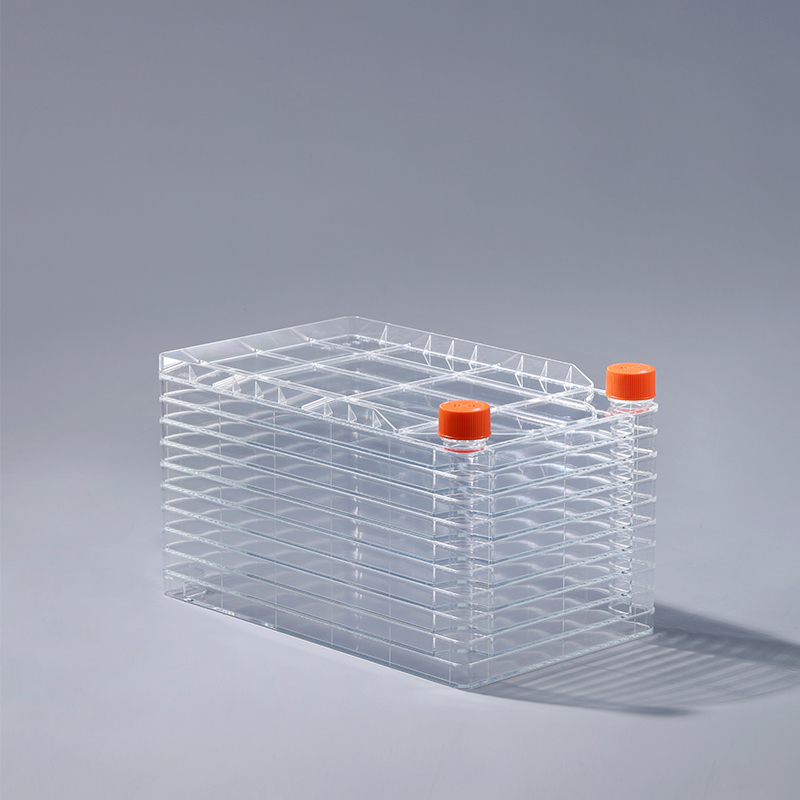là thiết bị nuôi cấy tế bào, được cấu tạo bởi một hoặc nhiều lớp tùy theo kích thước của vùng nuôi, có thể thực hiện nuôi cấy tế bào quy mô lớn, phù hợp với nhiều lĩnh vực như vắc xin, công nghiệp dược phẩm. hoặc kháng thể tạo dòng đơn phân. Nhà máy tế bào Nhà máy tế bào có thể đáp ứng nuôi cấy tế bào kết dính, và nó cũng thích hợp cho nuôi cấy tĩnh tế bào huyền phù. Nuôi cấy bám dính có nghĩa là các tế bào phải được gắn vào thành của bình (chai) nuôi cấy khi chúng được nuôi cấy. Một khi các tế bào được gắn vào, chúng sẽ lây lan nhanh chóng, sau đó bắt đầu nguyên phân và nhanh chóng bước vào giai đoạn tăng trưởng logarit. Nói chung một vài ngày sau, bề mặt nuôi cấy được bao phủ và hình thành một lớp đơn bào dày đặc, chẳng hạn như tế bào Vero, tế bào HEK 293, tế bào CAR-T, tế bào MRC5, tế bào CEF, đại thực bào phế nang lợn, tế bào u tủy, tế bào DF-1, Tế bào ST, tế bào PK15, tế bào Marc145, v.v. tất cả đều áp dụng phương pháp nuôi cấy kết dính.
Nuôi cấy treo đề cập đến hệ thống nuôi cấy mô nuôi cấy các tế bào đơn lẻ và các cụm tế bào nhỏ trong môi trường lỏng được kích động hoặc lắc liên tục. Sự phát triển của tế bào lơ lửng không phụ thuộc vào bề mặt của giá đỡ, và phát triển ở trạng thái lơ lửng trong môi trường nuôi cấy. Ví dụ, tế bào CHO, tế bào côn trùng, tế bào BHK21 và tế bào MDCK đều được sử dụng trong nuôi cấy huyền phù. nhu cầu kép của văn hóa kết dính và văn hóa đình chỉ, và được nhiều cơ quan nghiên cứu khoa học và công ty dược phẩm ưa chuộng.
Suspension culture refers to a tissue culture system that cultivates single cells and small cell clusters in a liquid medium that is constantly agitated or shaken. The growth of suspended cells does not depend on the surface of the support, and grows in a suspended state in the culture medium. For example, CHO cells, insect cells, BHK21 cells and MDCK cells are all used in suspension culture.
The cell factory utilizes the advantages of multi-layer structure and large area, and is widely used in industrial mass production to meet the dual needs of adherent culture and suspension culture, and is favored by many scientific research institutions and pharmaceutical companies.
The FAI climbed 5.9 percent year-on-year in the first 11 months of 2018, quickening from the 5.7-percent growth in Jan-Oct, the National Bureau of Statistics (NBS) said Friday in an online statement.
The key indicator of investment, dubbed a major growth driver, hit the bottom in August and has since started to rebound steadily.
In the face of emerging economic challenges home and abroad, China has stepped up efforts to stabilize investment, in particular rolling out measures to motivate private investors and channel funds into infrastructure.
Friday's data showed private investment, accounting for more than 60 percent of the total FAI, expanded by a brisk 8.7 percent.
NBS spokesperson Mao Shengyong said funds into weak economic links registered rapid increases as investment in environmental protection and agriculture jumped 42 percent and 12.5 percent respectively, much faster than the average.
In breakdown, investment in high-tech and equipment manufacturing remained vigorous with 16.1-percent and 11.6-percent increases respectively in the first 11 months. Infrastructure investment gained 3.7 percent, staying flat. Investment in property development rose 9.7 percent, also unchanged.
 English
English



















































